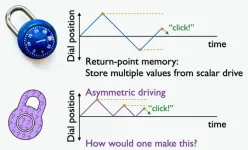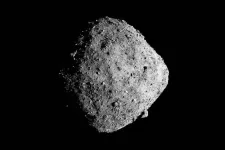(Press-News.org) UNDER EMBARGO UNTIL 19:00 GMT / 14:00 ET, WEDNESDAY 29 JANUARY 2025
Quantum-inspired computing drives major advance in simulating turbulence
Researchers at the University of Oxford have pioneered a new approach to simulate turbulent systems, based on probabilities. The findings have been published today (29 January) in the journal Science Advances.
Predicting the dynamics of turbulent fluid flows has long been a central goal for scientists and engineers. Yet, even with modern computing technology, direct and accurate simulation of all but the simplest turbulent flows remains impossible.
This is due to turbulence being characterised by eddies and swirls of various shapes and sizes interacting in chaotic and unpredictable manners. For uses within engineering or weather-prediction, these fluctuations cannot be accurately simulated even by the most powerful supercomputers.
Working with colleagues at Hamburg, Pittsburgh and Cornell, the Oxford researchers reframed the problem in a manner that entirely avoids the need to directly resolve and simulate these turbulent fluctuations. Rather than simulating the troublesome fluctuations directly, they modelled these as random variables distributed according to a probability distribution function. Simulating such probability distributions enabled them to extract all meaningful quantities from the flow (for instance, lift and drag), without having to worry about the chaos of turbulent fluctuations.
Normally, simulating turbulence probability distributions requires solving high-dimensional Fokker-Planck equations – something infeasible to do using classical methods. To overcome this, the team applied a quantum-inspired computing technology developed at the University of Oxford. This method uses 'tensor networks’ to represent the turbulence probability distributions in a hyper-compressed format that enabled their simulation.
In the study, the quantum-inspired computing algorithm running on a single CPU core required just a few hours to compute that which would take an equivalent classical algorithm several days to do on an entire supercomputer.
Yet this computational speedup is only the beginning: in the future, much greater gains are likely to be had by running the quantum-inspired tensor network algorithm on dedicated hardware, such as tensor processing units and fault-tolerant quantum chips.
According to the researchers, the approach not only questions the current limits of turbulence simulation, but also opens the door towards simulating other chaotic systems that can be described probabilistically.
Lead researcher Dr Nikita Gourianov (Department of Physics, University of Oxford) said: “The demonstrated - and future - computational advantage not only opens up new, previously inaccessible areas of turbulence physics for scientific probing, but also beckons next-generation computational fluid dynamics codes. These could end up improving our weather forecasts, make our cars more aerodynamic, increase the efficiency of chemical industries, and more.”
Notes to editors:
For media inquiries and interview requests, contact Dr Nikita Gourianov: nikgourianov@icloud.com
The study ‘Tensor networks enable the calculation of turbulence probability distributions’ will be published in Science Advances at https://www.science.org/doi/10.1126/sciadv.ads5990 at 19:00 GMT / 14:00 ET on Wednesday 29 January 2025. To view a copy of the paper before this under embargo, access the Science Advances press pack https://www.eurekalert.org/press/vancepak or contact: vancepak@aaas.org
About the University of Oxford:
Oxford University has been placed number 1 in the Times Higher Education World University Rankings for the ninth year running, and number 3 in the QS World Rankings 2024. At the heart of this success are the twin-pillars of our ground-breaking research and innovation and our distinctive educational offer.
Oxford is world-famous for research and teaching excellence and home to some of the most talented people from across the globe. Our work helps the lives of millions, solving real-world problems through a huge network of partnerships and collaborations. The breadth and interdisciplinary nature of our research alongside our personalised approach to teaching sparks imaginative and inventive insights and solutions.
Through its research commercialisation arm, Oxford University Innovation, Oxford is the highest university patent filer in the UK and is ranked first in the UK for university spinouts, having created more than 300 new companies since 1988. Over a third of these companies have been created in the past five years. The university is a catalyst for prosperity in Oxfordshire and the United Kingdom, contributing £15.7 billion to the UK economy in 2018/19, and supports more than 28,000 full time jobs.
The Department of Biology is a University of Oxford department within the Maths, Physical, and Life Sciences Division. It utilises academic strength in a broad range of bioscience disciplines to tackle global challenges such as food security, biodiversity loss, climate change and global pandemics. It also helps to train and equip the biologists of the future through holistic undergraduate and graduate courses. For more information visit www.biology.ox.ac.uk.
END
Quantum-inspired computing drives major advance in simulating turbulence
2025-01-29
ELSE PRESS RELEASES FROM THIS DATE:
New microscopy technique reveals dynamic Escherichia coli membrane stiffness
2025-01-29
Light and electron microscopy have distinct limitations. Light microscopy makes it difficult to resolve smaller and smaller features, and electron microscopy resolves small structures, but samples must be meticulously prepared, killing any live specimens.
Atomic force microscopy (AFM) is a technique originally developed to assess the physical and mechanical properties of materials at extremely high resolutions, but the imaging speeds aren’t fast enough (e.g. several minutes per frame) to capture relevant data for living biological samples. In contrast, another method, high-speed AFM (HS-AFM), is fast but cannot measure mechanical properties. Understanding ...
Bad hair bears! Greasy hair gives polar bears fur with anti-icing properties
2025-01-29
An international team of scientists has discovered the anti-icing secret of polar bear fur – something that allows one of the planet’s most iconic animals to survive and thrive in one of its most punishing climates. That secret? Greasy hair.
After some polar sleuthing, which involved scrutiny of hair collected from six polar bears in the wild, the scientists homed in on the hair “sebum” (or grease) as the all-important protectant. This sebum, which is made up of cholesterol, diacylglycerols, and fatty acids, makes it very hard for ice to attach to their fur.
While this finding ...
Materials can remember a sequence of events in an unexpected way
2025-01-29
UNIVERSITY PARK, Pa. — Many materials store information about what has happened to them in a sort of material memory, like wrinkles on a once crumpled piece of paper. Now, a team led by Penn State physicists has uncovered how, under specific conditions, some materials seemingly violate underlying mathematics to store memories about the sequence of previous deformations. According to the researchers, the method, described in a paper appearing today (Jan. 29) in the journal Science Advances, could inspire new ways to store information in ...
NewsGuard: Study finds no bias against conservative news outlets
2025-01-29
[Vienna, 29.01.2025]—A recent study evaluating the NewsGuard database, a leading media reliability rating service, has found no evidence supporting the allegation that NewsGuard is biased against conservative news outlets. Actually, the results suggest it’s unlikely that NewsGuard has an inherent bias in how it selects or rates right-leaning sources in the US, where trustworthiness is especially low.
“It seems unlikely that NewsGuard has an inherent bias against conservative sources, both in selecting and giving them lower ratings. Instead, the US media system is flooded with right-wing sources that tend to not adhere to professional ...
New tool can detect fast-spreading SARS-COV-2 variants before they take off
2025-01-29
By analysing millions of viral genome sequences from around the world, a team of scientists, led by the Peter Doherty Institute for Infection and Immunity (Doherty Institute) and the University of Pittsburgh, uncovered the specific mutations that give SARS-CoV-2 a ‘turbo boost’ in its ability to spread.
“Among thousands of SARS-CoV-2 mutations, we identified a small number that increase the virus’ ability to spread,” said Professor Matthew McKay, a Laboratory Head at the Doherty Institute and ARC Future Fellow in the Department of Electrical and Electronic Engineering at the University of Melbourne, and co-lead author of the ...
Berkeley Lab helps explore mysteries of Asteroid Bennu
2025-01-29
During the past year, there’s been an unusual set of samples at the Department of Energy’s Lawrence Berkeley National Laboratory (Berkeley Lab): material gathered from the 4.5-billion-year-old asteroid Bennu when it was roughly 200 million miles from Earth.
Berkeley Lab is one of more than 40 institutions investigating Bennu’s chemical makeup to better understand how our solar system and planets evolved. In a new study published today in the journal Nature, researchers found evidence that Bennu comes from an ancient wet world, with some material from the coldest regions of the solar system, likely beyond the orbit of ...
Princeton Chem discovers that common plastic pigment promotes depolymerization
2025-01-29
It turns out that the black plastic lid atop your coffee cup has a superpower. And the Stache Lab at Princeton Chemistry, which uncovered it, is exploiting that property to recycle at least two major types of plastic.
Their startling mechanism for promoting depolymerization relies on an additive that many plastics already contain: a pigment called carbon black that gives plastic its black color. Through a process called photothermal conversion, intense light is focused on plastic containing the pigment that jumpstarts the degradation.
So far, researchers have shown that carbon black can depolymerize polystyrene and polyvinyl chloride (PVC), two of the least recycled plastics in the planet’s ...
AI-driven multi-modal framework revolutionizes protein editing for scientific and medical breakthroughs
2025-01-29
Researchers from Zhejiang University and HKUST (Guangzhou) have developed a cutting-edge AI model, ProtET, that leverages multi-modal learning to enable controllable protein editing through text-based instructions. This innovative approach, published in Health Data Science, bridges the gap between biological language and protein sequence manipulation, enhancing functional protein design across domains like enzyme activity, stability, and antibody binding.
Proteins are the cornerstone of biological functions, and their precise modification holds immense potential for medical therapies, synthetic biology, and biotechnology. While traditional protein editing methods ...
Traces of ancient brine discovered on the asteroid Bennu contain minerals crucial to life
2025-01-29
A new analysis of samples from the asteroid Bennu, NASA’s first asteroid sample captured in space and delivered to Earth, reveals that evaporated water left a briny broth where salts and minerals allowed the elemental ingredients of life to intermingle and create more complex structures. The discovery suggests that extraterrestrial brines provided a crucial setting for the development of organic compounds.
In a paper published today, Jan. 29, in the journal Nature, scientists at the Smithsonian’s National Museum ...
Most mental health crisis services did not increase following 988 crisis hotline launch
2025-01-29
The launch of the nation’s 988 mental health hotline did not coincide with significant and equitable growth in the availability of most crisis services, except for a small increase in peer support services, according to a new RAND study.
Examining reports from thousands of mental health treatment facilities about the types of crisis services offered before and after the July 2022 rollout of the 988 hotline, researchers found that there was an increase in peer support services, a significant decrease in psychiatric walk-in services, and small declines in mobile crisis response and suicide prevention services.
Significant ...







